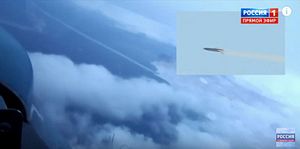Russian President Vladimir Putin announced during his annual State of the Nation address on March 1 that the Russian defense industry has begun developing an intercontinental-range nuclear-powered cruise missile capable of penetrating any interceptor-based missile defense system.
“We’ve started the development of new types of strategic weapons that do not use ballistic flight paths on the way to the target. This means that the missile defense systems are useless as a counter-means and just senseless,” Putin said in his speech.
“One of them is creation of a small-size highly powerful nuclear power plant that can be planted inside the hull of a cruise missile identical to our air-launched X-101 or the United States’ Tomahawk, but at the same time is capable of guaranteeing a flight range that is dozens of times greater, which is practically unlimited,” he added.
The Russian president’s speech included a short video showing an animation modelling the low-altitude flight of the terrain-hugging missile. (Part of the missile animation was apparently taken from a 2007 Russian television documentary.) The missile is presumably ground-launched.
“A low-flying low-visibility cruise missile armed with a nuclear warhead and possessing a practically unlimited range, unpredictable flight path and the capability to impregnate practically all interception lines is invulnerable to all existing and future anti-missile and air defense weapons,” Putin said.
He also noted that the new nuclear-powered cruise missile was already tested in 2017. “During the flight the power plant achieved the design capacity and thrust. The launch of the missile and the tests on the ground allow for starting work to create a fundamentally new type of weapon — a strategic nuclear missile equipped with a nuclear power plant,” he noted.
If a test indeed took place, it could have been a static ground test of the missile’s engine. However, Pentagon officials speaking to U.S. media noted that the missile has recently crashed during testing in the Arctic, although there have been no corresponding reports of radioactive pollution by European monitors. “The nuclear powered cruise missile Putin bragged about has actually crashed a few times,” one official told Fox News. “Think about the environmental impact of that,” the official added.
Despite the Pentagon’s comments, it still remains unclear whether the nuclear cruise missile project is part of a full-fledged R&D program. Notably, the new nuclear-powered cruise missile was not mentioned in the recently released U.S. Nuclear Posture Review (NPR), as my colleague Ankit Panda has pointed out, whereas the document discusses Russia’s new long-range nuclear torpedo, codenamed Status-6. (I reported on the Status-6 project in 2015 and 2016, noting that it could become operational in the mid-2020s.)
For what it’s worth, there are number of technical challenges that need to be addressed when designing a nuclear reactor for an intercontinental-range ramjet supersonic cruise missile. A paper published by Stanford University in 2015 discussing the U.S. Cold War-era Supersonic Low Altitude Missile (SLAM) program lists a number of challenges, including designing a lightweight reactor and the need to minimize radiation leakage from the reactor core.
As of now, no technical specifications of the purported nuclear-powered cruise have been revealed. The new missile would also likely not be covered by the new Strategic Arms Reduction Treaty (START), although they may be discussed by the two powers during consultations.
The diversification of Russia’s nuclear arsenal is a clear indication that Russian nuclear war planners are deeply concerned over advances in U.S. interceptor-based missile defense systems and fear for their second-strike capability. Additionally, the fact that the Russian president has revealed the development of a number of high-yield (i.e. strategic) nuclear weapons appears to somewhat undermine the claim by the authors of the Pentagon’s NPR that Russia is heavily focused on developing low-yield (tactical) nuclear weapons as part of its purported “escalate to deescalate” strategy.
During his 35-minute speech, Putin also revealed the existence of four additional strategic thermonuclear weapons systems including the Status-6 already discussed above, the Sarmat intercontinental ballistic missile (ICBM), a new hypersonic air-launched cruise missile, and the “Avangard” hypersonic glide vehicle.

































